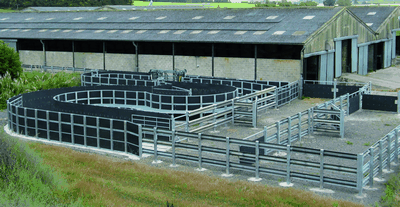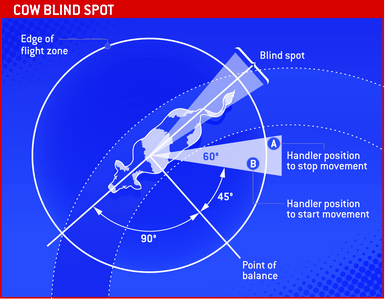Back to basics: Getting cattle handling systems right

Some readers will be familiar with the film Rainman, starring Dustin Hoffman as an autistic man with a brain capable of memorising phone books. You will be wondering why this has any relevance to cattle handling.
First, it is important to realise why Temple Grandin is the one lady qualified to tell producers how to handle their cattle and why, in essence, you should trust what she says. Dr Grandin is autistic. But she has harnessed this to become one of the most successful developmentally disabled people in our lifetime.
She freely admits she sees how a cow or, more broadly, an animal does – in pictures and not in words. Someone who compares her mind to a Google images search engine, Dr Grandin has written numerous books, including the New York Times bestseller Animals in Translation detailing how animals communicate.

In describing the way she views these similarities, she refers to a situation in which she told an engineer working in a meat plant he was stupid. “He had designed a piece of handling equipment which had obvious flaws to me. I visualise the whole system, just like a virtual computer program, which means the facility doesn’t have to be built for me to find potential flaws. It took me a long while to realise most people do not think in pictures and so cannot see what animals see.”
Behaviour
Animals either feel scared, aggressive, happy or sad, she believes. “Often aggressive behaviour is shown as fear, the main emotion in both animals and in autism. And the most common mistake is to punish an animal purely on this basis.”
So similar are her emotions to animals, and that after seeing cattle being immediately calmed in an American-style squeeze crush system, Dr Grandin decided to make her own. Evenly applied pressure helps relax both animals and those with autism, without the social consequences and impracticalities of being continually held close to another person.
But, before you think this smacks of horse whispering and is devoid of being of any real use on a beef farm, bear in mind that she has been responsible for overhauling many of the USA’s processing facilities, is an adviser for major processors such as McDonalds and Burger King and more than half of all north American beef animals are handled in a centre track system she has designed.
Research carried out by Dr Grandin on flight zones and curved handling systems has revolutionised handling on many farms worldwide, including the UK.

Tips for handling
The first step is to look at the basics, Dr Grandin says. “I prefer to watch animals in the handling system before appraising the facility, as they are the only ones able to identify the real problems.
“The minimum any cattle farm needs is a headgate and a single alley race system, somewhere to run animals in before securing them in a restraining mechanism. This may sound obvious, but some of the farms I visit don’t even have these basics, often resulting in substandard healthcare.”
Non-slip flooring is vital, if possible throughout the whole system, but essentially in the race itself and the collecting pen. “Even slipping 4-5cm, cows will keep pulling hooves back until panic sets in. Falling is an animals’ primal fear, so even the slightest slip causes panic. Welding rods flat and sinking them into concrete is a simple measure to create this equally effective is grooving concrete. This is the first thing producers should concentrate on in a handling system,” she adds.
“Watch animals go through the system, see where they back up or refuse and note this. Is it because of sharp edges or chains hanging down? Is the system facing into a dark shed or are there shadows interfering with cow flow?” Dr Grandin advises using light translucent plastic in handling sheds, which reduces shadows and helps keep light levels constant. “Often, handling cattle is far more trouble free on cloudy days, when there are fewer shadows and shiny objects distracting animals.
Observant
“Cattle are extremely observant and will often signal point of distress using eyes and ears. Another thing I cannot stand is shouting and screaming when handling, as this serves no purpose.”
Most handling systems in the UK have evolved from dairy equipment, which relies on animals being relatively tame and easy to handle. In North America, Dr Grandin highlights, beef cattle may only be handled once a year, which means the experience should be as calm and relaxed as possible.
She urges UK handling manufacturers to develop equipment which is more in line with that of the USA, such as the Pearson Squeeze Crush, the only commercially available squeeze system in the UK. “The difference between having animals held in a head restraint to the calming effect a squeeze crush is vastly noticeable and allows handlers to get to cattle far more easily for suckling, hoof trimming and many other routine tasks.”
Dr Grandin’s curved race design has revolutionised handling for those who have adopted the principles, but why does it work? Two main reasons: It prevents animals from seeing the lorry, the crush, or people until they are actually inside and also takes advantage of natural circling behaviour. But, she warns, refrain from making bends too sharp, as this will do more harm than good. Curves should be two cow lengths.
“Cattle will balk when a race appears to be a dead end, so animals must be able to see a way through, with sliding and one-way gates, able to be seen through by animals. External sides of races, holding pens and crushes should be solid so cattle cannot see through. This can be done cheaply from plywood or more expensively from plate.”
Understanding
Understanding cattle’s flight zone is key to quiet handling, Dr Grandin maintains. “When you penetrate the flight zone animals will move, when you retreat they will stop. The size of this flight zone is determined by several factors, including breed, degree of wildness and the angle at which the handler approaches.”
A cow coming directly towards you will have a greater flight zone than one passing you and flight zones will increase when cattle become excited. “Handlers must be far enough away so as not to panic animals, but close enough to make them move. When they start moving too fast, back off straight away, out of the flight zone.
“To move an animal forward, retreat back from the point of balance and to move it backward move in front of the shoulder,” she explains. “Beware of being in an animal’s blind spot at pasture and in a large pen, as this will cause cattle to stop and turn to look at you, stalling movement.”
Having floors consistent in the crush and pens is important, as subtle changes reduce cow flow markedly, she adds. “When the floor changes from loading alley to crush, animals will more than likely refuse on first approach. Blur floors into one, at the very least by spreading dirt over joining sections.”
Important
Handlers have to bear in mind the first time animals go through the race is important in how it will affect handling in later life, she says.
“The first experience of the crush should be as quick and trouble free as possible. Even running cattle through to feed them will aid in this process. Ensure crushes are set so as not to pinch or hurt animals.
“Keeping animals calmer during handling results in better weight gain, less stress on handlers and considerably better breeding success, so it is worth taking the time to get it right.”
When handling, don’t forget fundamental principles, such as working races half full, but never with animals on their own, Grandin adds. “When the holding pen can hold 16, work with eight or nine, so there is enough room to handle them effectively. Rather than sticks or prods, try a stick with a plastic bag to turn stock.
“When animals are being loaded onto a trailer, many will resist going into a black hole. When there is a door at the far end, open this to let light in, settling animals.” In addition, she adds, ensure all trailer flooring is non slip and, if needs be, straw the ramp to give the impression of the ramp and the floor being similar.
